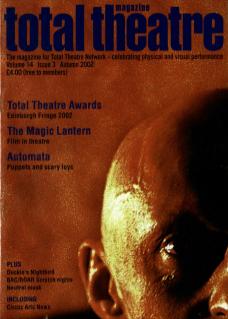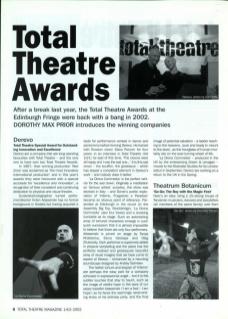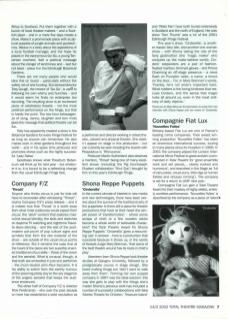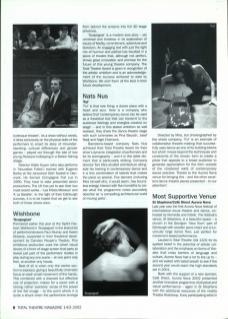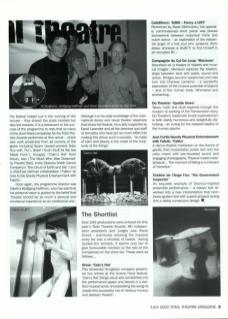Derevo
Total Theatre Special Award for Outstanding Innovation and Excellence
Derevo are a company that are long-standing favourites with Total Theatre – and the only one to have won two Total Theatre Awards.
In 1997, their winning production Red Zone was acclaimed as the most innovative international production and in this year's awards they were honoured with a special accolade for 'excellence and innovation’, a recognition of their consistent and continuing dedication to physical and visual theatre.
Guitarist/photographer turned performer/director Anton Adassinski has no formal background in theatre but having acquired a taste for performance worked in dance and pantomime before forming Derevo. He trained with Russian clown Slava Polunin for four years; in an interview in Total Theatre (Vol 10/1) he said of this time, ‘The clowns were all happy and I was the sad one...’ It is this sad clown – the bouffon, the grotesque – which has stayed a consistent element in Derevo's work – and nobody does it better.
La Divina Commedia is the perfect vehicle for the sad clown. Originally a meditation on famous artists' suicides, the show was devised in Italy – and Dante's poetic exploration of 'Inferno, Purgatorio e Paradiso’ became an obvious point of reference. Presented at Edinburgh in the round (in the Assembly Big Top, Stockbridge), La Divina Commedia uses four towers and a revolving turntable as its stage. Such an astonishing array of tortured characters emerge in such quick succession that it is almost impossible to believe that there are only four performers. Adassinski is joined on stage by Tanya Khabarova, Elena Yarovaya and Oleg Zhukovsky. Each performer is supremely skilled in physical storytelling and the piece has the perfectly realised and grotesquely beautiful array of visual imagery that we have come to expect of Derevo – enhanced by a haunting soundscape designed by Andrey Sizintsev.
The hellish torture and despair of 'Inferno’ are perhaps the easy part for a company schooled in expressionist angst – but it is the subtler touches that stay to haunt, such as the image of wistful hope in the eyes of our weary traveller Adassinski ('I am a fool – I am hope') as he faces the seemingly never-ending limbo of his birthday party, and the final image of potential salvation – a ladder reaching to the heavens, ‘pure and ready to mount to the stars', as the hourglass of human mortality sits on the ever-turning wheel of life.
La Divina Commedia – produced in the UK by the enterprising Green & Lenagan – moved to the Riverside Studios for its London debut in September. Derevo are working on a return to the UK in the Spring.
Theatrum Botanicum
Go-Go: The Boy with the Magic Feet
Here's an idea: bring a 15-strong troupe of Tanzanian musicians, dancers and storytellers (all members of the same family) over from Africa to Scotland. Put them together with a bunch of local theatre makers – and a Scottish piper – and in a mere five days create a show. Make it a promenade piece with sculptural puppets of jungle animals and pyrotechnics. Weave in a story about the aspirations of a local football manager, and the hope he places in the eponymous Go-Go, a young Tanzanian cowherd. Add a political message about the danger of landmines and – last but not least – place it in the Edinburgh Botanical Gardens.
There are not many people who would take this on board – particularly without the safety net of arts funding. But deviser/director Toby Gough, the creator of Go-Go, is used to following his own whims and hunches – and it would seem he finds no enterprise too daunting. The resulting show is an exuberant piece of celebratory theatre – not the most polished performance on the fringe, but that is hardly the point. The two-hour extravaganza of song, dance, laughter and bon mots gives the message that political theatre can be fun.
Toby has apparently created a show in the Botanical Gardens for every Fringe Festival for as long as anyone can remember. He also makes work in other gardens throughout the world – and in his spare time produces and promotes shows such as the highly successful Lady Salsa.
Goodness knows what Theatrum Botanicum will think up for next year – but whatever it is, it is bound to be a refreshing change from the usual Edinburgh Fringe fare.
Company F/Z
Throat
‘Anyone who thinks circus is just for kids will have to reconsider after witnessing Throat’ claims Company F/Z's press release – and it is indeed true that Throat is a world away from what most audiences would expect from circus: the 'adult' content that explores masculine sexual identity; the skits and sketches on daytime TV watching and night-time Travolta disco-dancing – and the rest of the postmodern pot-pourri of pop culture signs and symbols that form the raw material of the show – are outside of the usual circus points of reference. But it remains the case that at the heart of the piece are two superbly enacted traditional circus skills – those of the clown and the aerialist. What is unusual, though, is that both are embodied in just one performer – the much-lauded John-Paul Zaccarini. It is his ability to switch from the earthly humour of the preening pretty-boy to the airy elegance of the angelic aerialist that keeps the audience entranced.
The other half of Company F/Z is director Flick Ferdinando – who over the past decade or more has established a solid reputation as a performer and director working in street theatre, cabaret and physical theatre. She doesn't appear on stage in this production – but can currently be seen treading the boards with Peepolykus in Rhinoceros.
Producer Martin Sutherland also deserves a mention, Throat being one of many excellent shows (including the Pig Iron/Joseph Chaiken collaboration Shut Eye) brought by him to this year's Edinburgh Fringe.
Shona Reppe Puppets
Cinderella
In the current climate of interest in new media and new technologies, there have been worries about the survival of the traditional arts of the puppeteer. Is there still a place for theatre productions that have at their heart the simple power of transformation – where some scraps of cloth or a few wooden sticks become a whole world of believable characters? The Total Theatre Award for Shona Reppe Puppets’ Cinderella gives a resounding 'yes' in answer – here is a production that succeeds because it shows us, in the words of Awards Judge Mary Brennan, that some of the best theatre around has its roots in child's play.
Aberdeen-born Shona Reppe took theatre studies at Glasgow University, followed by a postgraduate course in stage design. She loved making things but ‘didn't want to walk away from them'. Forming her own puppet company in 1997 was the ideal solution: this way she gets to play with the things she's made! Shona's previous work has included a number of successful collaborations with Wee Stories Theatre for Children; Treasure Island and Peter Pan have both toured extensively in Scotland and the north of England. Her solo show Tom Thumb was a hit of the 2001 Edinburgh Fringe Festival.
This year's show, Cinderella, is another classic fairy tale, and another one-woman show – with Shona taking the role of the fairy godmother (the 'magic maker' who conjures up the make-believe world). Cinders' stepsisters are a pair of fashion-fixated maribou trimmed gloves, and Prince Charming an off-stage presence – a news flash on Pumpkin radio, a name, a knock on the door... For, in Mary Brennan's words, ‘Frankly, he's not what's important here. What matters is the loving kindness that rescues Cinders, and the sense that magic lurks all around us, even in the most ordinary of daily objects.’
Thank you to Mary Brennan for permission to quote from her interview with Shona Reppe and her review of Cinderella.
Compagnie Fiat Lux
Nouvelles Folies
Brittany-based Fiat Lux are one of France's leading mime companies. Their award winning production Nouvelles Folies has been an enormous international success, touring to many places since its inception in 1999. In 2001 the company played the London International Mime Festival to great acclaim (commended in Total Theatre for ‘good ensemble work and set pieces... clearly evoked and humorous', and described in The Stage as ‘full of zany jokes, visual puns, little digs at human foibles and virtuoso miming'). The company is set for a return to LIMF next year.
Compagnie Fiat Lux gain a Total Theatre Award for their mastery of highly skilled, entirely wordless performance. Nouvelles Folies is described by the company as a piece of 'silent burlesque theatre'. As a show without words, it relies exclusively on the physical skills of the performers to enact its story of misunderstanding, cultural differences and gender games – played out through the tale of two young Parisians holidaying in a Breton fishing village
Director Didier Guyon (who also performs in Nouvelles Folies) trained with Eugenio Barba at the renowned Odin Teatret in Denmark. He formed Compagnie Fiat Lux in 1990. They have to date presented seven productions. The UK has yet to see their two most recent works – Les Frères Morveux and À La Bastille. In the light of their Edinburgh success, it is to be hoped that we get to see both of these shows soon.
Wishbone
Scapegoat
Premiered earlier this year at the Sprint Festival, Wishbone's Scapegoat is the brainchild of performer/devisers Paul Murray and Karen Glossop, supported in their theatrical development by Camden People's Theatre. This ambitious production uses the clever visual device of a front-of-stage screen that parts to reveal just part of the performers bodies in play during any one scene – at one point only feet, at another only heads.
Best of all is when only the centre section is exposed, giving a beautifully cinematic focus on each small movement of the hands. This, combined with a discreet but effective use of projection, makes for a piece with a strong, rather ‘painterly' sense of the power of the flat image to the point where it is quite a shock when the performers emerge from behind the screens into full 3D stage presence.
Scapegoat is a modern love story – yet universal and timeless in its exploration of issues of fidelity, commitment, adventure and boredom. An engaging text with just the right mix of humour and pathos has resulted in a piece of theatre that, although not perfect, shows great innovation and promise for the future of this young theatre company. The Total Theatre Award is given in recognition of the artistic ambition and is an acknowledgement of the success achieved to date by Wishbone. We wish them all the best in their future development.
Nats Nus
Ful
Ful is that rare thing: a dance piece with a heart and soul. Here is a company who believe that ‘contemporary dance can be used as a theatrical tool that can transmit to the audience feelings and energies created on stage' – and in this stated ambition so well realised, they share the dance-theatre stage with such luminaries as Pina Bausch, Josef Nadj and Nigel Charnock.
Barcelona-based company Nats Nus achieved their Total Theatre Award for their show's dynamic integration of performers and for its scenography – and it is this latter element that is particularly striking. Company director Toni Mira studied architecture alongside his training in contemporary dance and it is this combination of talents that makes the piece so special. Five dancers (including Mira himself who, it would seem, has boundless energy) interact with five monoliths to create what the programme notes accurately describe as 'a compelling architectural world of moving parts'.
Directed by Mira, but choreographed by the whole company, Ful is an example of collaborative theatre-making that successfully uses dance as one of its building blocks but which moves beyond the techniques and constraints of the chosen form to create a piece that appeals to a broad audience to generate appreciation for the form outside of the cloistered walls of contemporary dance practice. Thanks to the Aurora Nova venue for bringing this and the other excellent dance-theatre pieces presented to our attention!
Most Supportive Venue
St Stephens/Café Direct Aurora Nova
Last year saw the first Aurora Nova festival of international visual theatre and dance, co-hosted by Komedia and Fabrik. The festival's venue, St Stephens, is a beautiful space – a church in the Georgian 'New Town' part of Edinburgh with wooden pews intact and a luxuriously large dance floor, just perfect for movement-based performance.
Lauded in Total Theatre (Vol 13/3) for its spirited belief in the potential of artistic collaboration and the emphasis on forms of theatre that cross barriers of language and culture, Aurora Nova had a lot to live up to – and we waited with bated breath to see if the second year would reach the high standards set in 2001.
Back with the support of a new sponsor, Café Direct, Aurora Nova 2002 presented another innovative programme of physical and visual performance – again in St Stephens with the additional resources of the nearby Theatre Workshop. Every participating artist in the festival helped out in the running of the venues – they shared the costs involved but also the rewards. It is a testament to the success of the programme to note that so many of the short-listed companies for the Total Theatre Awards performed at this venue – which saw work presented from all comers of the globe including Spain (award-winners Nats Nus with Ful), Brazil (Such Stuff As We Are Made From), Hungary (Cain's Hat from Artus), Iran (The Mute Who Was Dreamed by Theatre Bazi), India (Daksha Sheth Dance Company's The Circus of Earth and Sky), and a USA / East German collaboration (Fallen by Jess Curtis Gravity Physical Entertainment with Fabrik).
Once again, the programme director was Fabrik's Wolfgang Hoffman, who has said that his personal vision is guided by the belief that theatre should be ‘as much a sensual and emotional experience as an intellectual one'.
Although it is his wide knowledge of the international dance and visual theatre repertoire that drives the festival, he is ably supported by David Lavender and all the directors and staff at Komedia who have put so much effort into making this venue such a success – an oasis of calm and beauty in the midst of the hurly-burly of the Fringe.
The Shortlist
Over 200 productions were entered for this year's Total Theatre Awards. 80 independent assessors and judges saw these shows – eventually reducing the massive entry list into a shortlist of twelve. Having lauded the winners, it seems only fair to give honourable mention to the rest of the companies on the short list. These were as follows...
Artus, Cain's Hat
This renowned Hungarian company presented two shows at the Aurora Nova festival. Cain's Hat brings visual arts sensibilities into the performance space and blends in a perfect musical score (incorporating live song) to create this successful mix of 'serious humour and abstract theatre'.
CafeDirect, 5065 – Fancy a Lift?
Performed by Alexei Merkushev, this specially commissioned short piece was placed somewhere between corporeal mime and butoh dance – an exploration of the existential angst of a lost soul who awakens (from sleep, amnesia or death?) to find himself in an occupied lift...
Compagnie Au Cul Du Loup, Monsoon
Described as 'a theatre of objects and musical images', Monsoon explores the relationships between land and water, sound and action. Bridges become xylophones and hats turn into Chinese Lanterns – a wonderful exploration of the musical potential of objects – and of the human body. Whimsical and enchanting.
Do Theatre, Upside Down
Taboo, myth and ritual are explored through this modem reworking of the Frankenstein story. Do Theatre's trademark brutal expressionism is both darkly humorous and delightfully disturbing – an outing for the deepest depths of the human psyche.
Jess Curtis Gravity Physical Entertainment with Fabrik, Fallen
A dance-theatre meditation on the theme of gravity that incorporates poetic text and live cello mixed with pre-recorded sound and engaging choreography. Physical meets metaphysical... ;the moment of falling is a moment of transition’.
Théâtre de l'Ange Fou, The Government Inspector
An exquisite example of Decroux-inspired ensemble performance – a classic text reworked into a new interpretation that combines spoken text with superb physical acting and a darkly sumptuous design.
